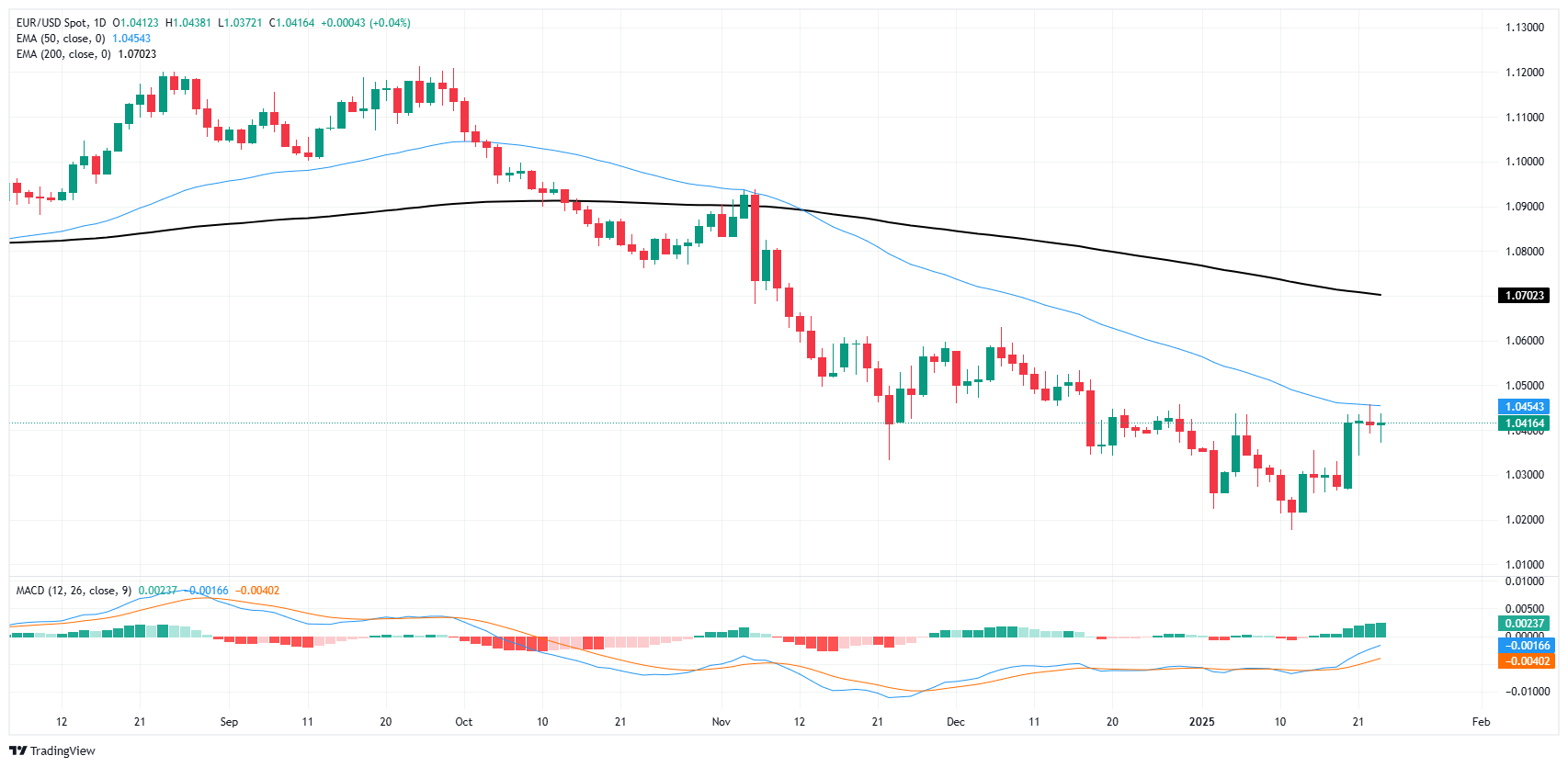EUR/USD continues sideways grind as markets look for a spark
- EUR/USD flattened near 1.0400 on Thursday.
- Investors are riding a tepid wave with a notable lack of data.
- Friday’s global PMI print to cap off an otherwise unremarkable week.
EUR/USD flatlined on Thursday, cycling near the 1.0400 handle as investors grind through a largely unremarkable week despite a strong start on Monday. A lack of meaningful economic docket data isn’t doing already-tepid markets any favors, and political headlines are driving most of what little trading volume exists.
President Donald Trump lashed out about a wide variety of topics during his appearance at the WEF’s annual gathering in Switzerland, colloquially referred to as Davos, the city that hosts the forum every year. President Trump reminded everyone listening that he intended to “obliterate” the US budget deficit, while somehow convincing the US Congress to pass “the largest tax cut in American history” at the same time. Donald Trump also vowed to attempt to subvert the operational independence of the US Federal Reserve (Fed) by demanding lower interest rates.
Fiber traders will have to settle for focusing on Friday’s Purchasing Managers Index (PMI) figures due from both the EU and the US. Both EU and US PMI business activity survey results for January are expected to come in mixed this week. The services components expected to tick down, or in the EU’s case, hold flat, and manufacturing to recover, albeit slightly. PMI figures generally have a limited impact unless figures come in wildly out of sync with forecasts, but survey respondent rates tend to be on the low side, and the overall figures should be taken with a grain of salt.
EUR/USD price forecast
Fiber bulls lost steam just below the 50-day Exponential Moving Average (EMA) around 1.0460, missing the 1.0450 level and pushing bids down into the 1.0400 range. Recent bullish momentum has gradually diminished, even after a 2.75% increase from last week’s drop into fresh two-year lows beneath 1.0200.
While technical indicators have recently shifted to bullish signals after previously suggesting oversold conditions, maintaining sustained momentum remains a challenge. Traders seeking a longer-term bullish correction should wait for price action to affirm a higher low pattern before looking for technical signals to enter the market.
EUR/USD daily chart
Euro FAQs
The Euro is the currency for the 19 European Union countries that belong to the Eurozone. It is the second most heavily traded currency in the world behind the US Dollar. In 2022, it accounted for 31% of all foreign exchange transactions, with an average daily turnover of over $2.2 trillion a day. EUR/USD is the most heavily traded currency pair in the world, accounting for an estimated 30% off all transactions, followed by EUR/JPY (4%), EUR/GBP (3%) and EUR/AUD (2%).
The European Central Bank (ECB) in Frankfurt, Germany, is the reserve bank for the Eurozone. The ECB sets interest rates and manages monetary policy. The ECB’s primary mandate is to maintain price stability, which means either controlling inflation or stimulating growth. Its primary tool is the raising or lowering of interest rates. Relatively high interest rates – or the expectation of higher rates – will usually benefit the Euro and vice versa. The ECB Governing Council makes monetary policy decisions at meetings held eight times a year. Decisions are made by heads of the Eurozone national banks and six permanent members, including the President of the ECB, Christine Lagarde.
Eurozone inflation data, measured by the Harmonized Index of Consumer Prices (HICP), is an important econometric for the Euro. If inflation rises more than expected, especially if above the ECB’s 2% target, it obliges the ECB to raise interest rates to bring it back under control. Relatively high interest rates compared to its counterparts will usually benefit the Euro, as it makes the region more attractive as a place for global investors to park their money.
Data releases gauge the health of the economy and can impact on the Euro. Indicators such as GDP, Manufacturing and Services PMIs, employment, and consumer sentiment surveys can all influence the direction of the single currency. A strong economy is good for the Euro. Not only does it attract more foreign investment but it may encourage the ECB to put up interest rates, which will directly strengthen the Euro. Otherwise, if economic data is weak, the Euro is likely to fall. Economic data for the four largest economies in the euro area (Germany, France, Italy and Spain) are especially significant, as they account for 75% of the Eurozone’s economy.
Another significant data release for the Euro is the Trade Balance. This indicator measures the difference between what a country earns from its exports and what it spends on imports over a given period. If a country produces highly sought after exports then its currency will gain in value purely from the extra demand created from foreign buyers seeking to purchase these goods. Therefore, a positive net Trade Balance strengthens a currency and vice versa for a negative balance.


